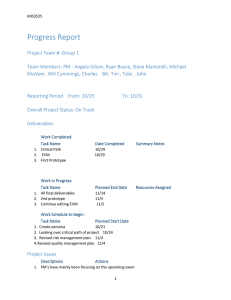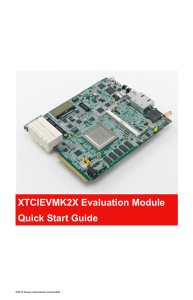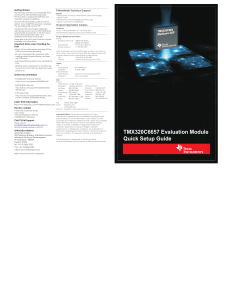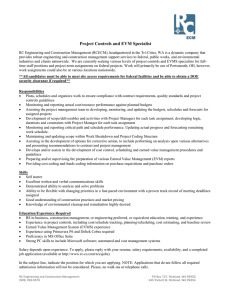Power-Distribution Switch With Adjustable Current
advertisement
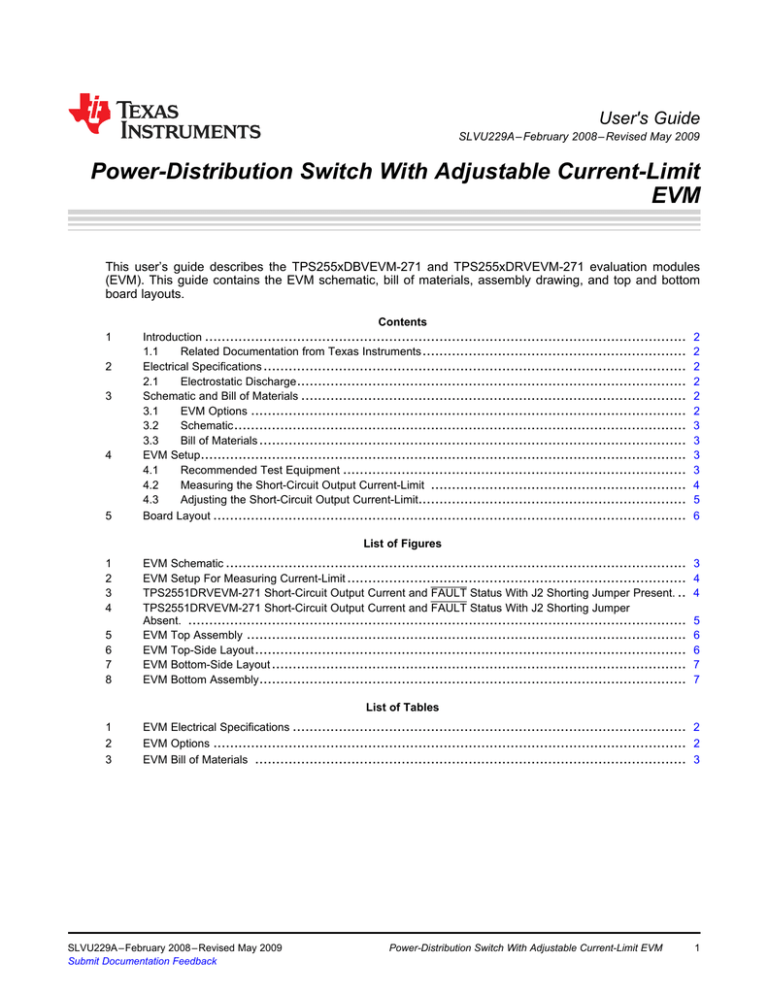
User's Guide SLVU229A – February 2008 – Revised May 2009 Power-Distribution Switch With Adjustable Current-Limit EVM This user’s guide describes the TPS255xDBVEVM-271 and TPS255xDRVEVM-271 evaluation modules (EVM). This guide contains the EVM schematic, bill of materials, assembly drawing, and top and bottom board layouts. 1 2 3 4 5 Contents Introduction ................................................................................................................... 1.1 Related Documentation from Texas Instruments ............................................................... Electrical Specifications ..................................................................................................... 2.1 Electrostatic Discharge ............................................................................................. Schematic and Bill of Materials ............................................................................................ 3.1 EVM Options ........................................................................................................ 3.2 Schematic ............................................................................................................ 3.3 Bill of Materials ...................................................................................................... EVM Setup.................................................................................................................... 4.1 Recommended Test Equipment .................................................................................. 4.2 Measuring the Short-Circuit Output Current-Limit ............................................................. 4.3 Adjusting the Short-Circuit Output Current-Limit................................................................ Board Layout ................................................................................................................. 2 2 2 2 2 2 3 3 3 3 4 5 6 List of Figures 1 2 3 4 5 6 7 8 EVM Schematic .............................................................................................................. EVM Setup For Measuring Current-Limit ................................................................................. TPS2551DRVEVM-271 Short-Circuit Output Current and FAULT Status With J2 Shorting Jumper Present. .. TPS2551DRVEVM-271 Short-Circuit Output Current and FAULT Status With J2 Shorting Jumper Absent. ....................................................................................................................... EVM Top Assembly ......................................................................................................... EVM Top-Side Layout ....................................................................................................... EVM Bottom-Side Layout ................................................................................................... EVM Bottom Assembly...................................................................................................... 3 4 4 5 6 6 7 7 List of Tables 1 2 3 EVM Electrical Specifications .............................................................................................. 2 EVM Options ................................................................................................................. 2 EVM Bill of Materials ....................................................................................................... 3 SLVU229A – February 2008 – Revised May 2009 Submit Documentation Feedback Power-Distribution Switch With Adjustable Current-Limit EVM 1 Introduction 1 www.ti.com Introduction The TPS255xDBVEVM-271 and TPS255xDRVEVM-271 are evaluation modules (EVM) for Texas Instruments’ family of power-distribution switches with adjustable current-limit. These EVMs operate over a 2.5-V to 6.5-V range. An onboard jumper sets the output current-limit to either 0.5 A or 1 A. Test points provide convenient access to all critical node voltages. The silkscreen outline on the PCB top-side encloses components found in a typical USB application. The PCB top-side accepts a power-distribution switch in a SOT23-6 package; the PCB bottom side accepts a power-distribution switch in the smaller SON package with a thermal pad. These switches have an enable input, an overcurrent status output, and overtemperature shutdown. 1.1 Related Documentation from Texas Instruments TPS2550, TPS2551 data sheet (SLVS736) 2 Electrical Specifications The EVM meets the electrical specifications in Table 1 over the recommended operating junction-temperature range of -40°C ≤ Tj ≤ 105°C for the DRV (SON) package and -40°C ≤ Tj ≤ 125°C for the DBV (SOT23-6) package. Table 1. EVM Electrical Specifications 2.1 Parameter Condition Input voltage, Vin J1 Min Short-Circuit Output Current-Limit, ILIMIT J2 shorting-jumper is absent, J3 is short circuited, TPS255x is enabled 0.60 0.65 0.72 Ampere J2 shorting-jumper is present, J3 is short circuited, TPS255x is enabled 1.20 1.28 1.38 2.5 Typ Max – Unit 6.5 Volt Electrostatic Discharge The EVM has been tested to IEC 61000-4-2. The level used was 8-kV contact discharge and 15-kV air discharge. Surges were applied to the EVM input and output. No damage to the TPS255x was observed. 3 Schematic and Bill of Materials 3.1 EVM Options Table 2. EVM Options 2 EVM Device Device Package Enable TPS2550DBVEVM-271 TPS2550DBV SOT23-6 Active Low TPS2551DBVEVM-271 TPS2551DBV SOT23-6 Active High TPS2550DRVEVM-271 TPS2550DRV SON Active Low TPS2551DRVEVM-271 TPS2551DRV SON Active High Power-Distribution Switch With Adjustable Current-Limit EVM SLVU229A – February 2008 – Revised May 2009 Submit Documentation Feedback EVM Setup www.ti.com 3.2 Schematic + See Table 3. Figure 1. EVM Schematic 3.3 Bill of Materials Table 3. EVM Bill of Materials QTY -001 RefDes Value Description Size Part Number MFR -002 -003 -004 1 1 1 1 C1 10µF Capacitor, Ceramic, 10-µF, X7R, 10V, 10% 1206 STD STD 2 2 2 2 C2, C3 0.1µF Capacitor, Ceramic, 16V, X7R, 10% 0805 STD STD 1 1 1 1 C4 150µF Capacitor, Tantalum, 150µF, 10V, 100mΩ, 10% 7343 (D) B45197A2157K409 Kemet 1 0 0 0 U1 TPS2550DBV IC, Power-Distribution Switch, Current-Limited SOT-23-6 TPS2550DBV TI 0 1 0 0 U1 TPS2551DBV IC, Power-Distribution Switch, Current-Limited SOT-23-6 TPS2551DBV TI 0 0 1 0 U2 TPS2550DRV IC, Power-Distribution Switch, Current-Limited SON TPS2550DRV TI 0 0 0 1 U2 TPS2551DRV IC, Power-Distribution Switch, Current-Limited SON TPS2551DRV TI 1 1 1 1 -- HPA271 PCB, 2.25 In × 2.225 In × 0.062 In HPA271 Any 2 2 2 2 R1, R2 10.0K Resistor, Chip, 1/10W, 1% 0805 CRCW0805-1002F Vishay 2 2 2 2 R3, R4 20.0K Resistor, Chip, 1/10W, 1% 0805 CRCW0805-2002-F Vishay 4 EVM Setup 4.1 Recommended Test Equipment The following test equipment is recommended: • Two-channel storage oscilloscope • Current probe • Voltage probe • An adjustable power supply with a 2.5-V to 6.5-V output and a 5-A output current-limit • Volt-ohm meter SLVU229A – February 2008 – Revised May 2009 Submit Documentation Feedback Power-Distribution Switch With Adjustable Current-Limit EVM 3 EVM Setup • 4.2 www.ti.com A passive or active load capable of handling 3 A. Measuring the Short-Circuit Output Current-Limit The user should read the TPS2550/1 data sheet before using the EVM. Figure 2 shows the EVM test setup for measuring current-limit. Switch S1 enables the power-distribution switch into a short circuit for this measurement. Figure 3 shows the current waveform for the TPS2551DRVEVM-271 with a shorting jumper populating header J2; Figure 4 shows the current waveform with header J2 unpopulated. Oscilloscope Voltage Probe FAULT Current Probe + IN - 5V, 5A EVM + OUT - 0-W 7" Twisted Pair, #20AWG Figure 2. EVM Setup For Measuring Current-Limit FAULT# ILIMIT lin Figure 3. TPS2551DRVEVM-271 Short-Circuit Output Current and FAULT Status With J2 Shorting Jumper Present. 4 Power-Distribution Switch With Adjustable Current-Limit EVM SLVU229A – February 2008 – Revised May 2009 Submit Documentation Feedback EVM Setup www.ti.com FAULT# ILIMIT lin Figure 4. TPS2551DRVEVM-271 Short-Circuit Output Current and FAULT Status With J2 Shorting Jumper Absent. 4.3 Adjusting the Short-Circuit Output Current-Limit The EVM provides two current-limit settings. If a different setting is required, then populate header J2 with a shorting jumper and modify resistor R3 according to Equation 1: 1 1.114 R3 = 28700 (ILIMIT ) (1) Where: 15 kΩ ≤ R3 ≤ 80.6 kΩ. The current-limit programming resistance, R3, is expressed in kΩ and the typical current-limit, ILIMIT, is expressed in mA. See the TPS2550/1 data sheet for the worst-case current-limit variation. SLVU229A – February 2008 – Revised May 2009 Submit Documentation Feedback Power-Distribution Switch With Adjustable Current-Limit EVM 5 Board Layout 5 www.ti.com Board Layout Figure 5. EVM Top Assembly Figure 6. EVM Top-Side Layout 6 Power-Distribution Switch With Adjustable Current-Limit EVM SLVU229A – February 2008 – Revised May 2009 Submit Documentation Feedback Board Layout www.ti.com Figure 7. EVM Bottom-Side Layout Figure 8. EVM Bottom Assembly SLVU229A – February 2008 – Revised May 2009 Submit Documentation Feedback Power-Distribution Switch With Adjustable Current-Limit EVM 7 EVALUATION BOARD/KIT IMPORTANT NOTICE Texas Instruments (TI) provides the enclosed product(s) under the following conditions: This evaluation board/kit is intended for use for ENGINEERING DEVELOPMENT, DEMONSTRATION, OR EVALUATION PURPOSES ONLY and is not considered by TI to be a finished end-product fit for general consumer use. Persons handling the product(s) must have electronics training and observe good engineering practice standards. As such, the goods being provided are not intended to be complete in terms of required design-, marketing-, and/or manufacturing-related protective considerations, including product safety and environmental measures typically found in end products that incorporate such semiconductor components or circuit boards. This evaluation board/kit does not fall within the scope of the European Union directives regarding electromagnetic compatibility, restricted substances (RoHS), recycling (WEEE), FCC, CE or UL, and therefore may not meet the technical requirements of these directives or other related directives. Should this evaluation board/kit not meet the specifications indicated in the User’s Guide, the board/kit may be returned within 30 days from the date of delivery for a full refund. THE FOREGOING WARRANTY IS THE EXCLUSIVE WARRANTY MADE BY SELLER TO BUYER AND IS IN LIEU OF ALL OTHER WARRANTIES, EXPRESSED, IMPLIED, OR STATUTORY, INCLUDING ANY WARRANTY OF MERCHANTABILITY OR FITNESS FOR ANY PARTICULAR PURPOSE. The user assumes all responsibility and liability for proper and safe handling of the goods. Further, the user indemnifies TI from all claims arising from the handling or use of the goods. Due to the open construction of the product, it is the user’s responsibility to take any and all appropriate precautions with regard to electrostatic discharge. EXCEPT TO THE EXTENT OF THE INDEMNITY SET FORTH ABOVE, NEITHER PARTY SHALL BE LIABLE TO THE OTHER FOR ANY INDIRECT, SPECIAL, INCIDENTAL, OR CONSEQUENTIAL DAMAGES. TI currently deals with a variety of customers for products, and therefore our arrangement with the user is not exclusive. TI assumes no liability for applications assistance, customer product design, software performance, or infringement of patents or services described herein. Please read the User’s Guide and, specifically, the Warnings and Restrictions notice in the User’s Guide prior to handling the product. This notice contains important safety information about temperatures and voltages. For additional information on TI’s environmental and/or safety programs, please contact the TI application engineer or visit www.ti.com/esh. No license is granted under any patent right or other intellectual property right of TI covering or relating to any machine, process, or combination in which such TI products or services might be or are used. FCC Warning This evaluation board/kit is intended for use for ENGINEERING DEVELOPMENT, DEMONSTRATION, OR EVALUATION PURPOSES ONLY and is not considered by TI to be a finished end-product fit for general consumer use. It generates, uses, and can radiate radio frequency energy and has not been tested for compliance with the limits of computing devices pursuant to part 15 of FCC rules, which are designed to provide reasonable protection against radio frequency interference. Operation of this equipment in other environments may cause interference with radio communications, in which case the user at his own expense will be required to take whatever measures may be required to correct this interference. EVM WARNINGS AND RESTRICTIONS It is important to operate this EVM within the input voltage range of 2.5 V to 6.5 V and the output voltage range of 2.5 V to 6.5 V. Exceeding the specified input range may cause unexpected operation and/or irreversible damage to the EVM. If there are questions concerning the input range, please contact a TI field representative prior to connecting the input power. Applying loads outside of the specified output range may result in unintended operation and/or possible permanent damage to the EVM. Please consult the EVM User's Guide prior to connecting any load to the EVM output. If there is uncertainty as to the load specification, please contact a TI field representative. During normal operation, some circuit components may have case temperatures greater than 85°C. The EVM is designed to operate properly with certain components above 85°C as long as the input and output ranges are maintained. These components include but are not limited to linear regulators, switching transistors, pass transistors, and current sense resistors. These types of devices can be identified using the EVM schematic located in the EVM User's Guide. When placing measurement probes near these devices during operation, please be aware that these devices may be very warm to the touch. Mailing Address: Texas Instruments, Post Office Box 655303, Dallas, Texas 75265 Copyright © 2009, Texas Instruments Incorporated IMPORTANT NOTICE Texas Instruments Incorporated and its subsidiaries (TI) reserve the right to make corrections, modifications, enhancements, improvements, and other changes to its products and services at any time and to discontinue any product or service without notice. Customers should obtain the latest relevant information before placing orders and should verify that such information is current and complete. All products are sold subject to TI’s terms and conditions of sale supplied at the time of order acknowledgment. TI warrants performance of its hardware products to the specifications applicable at the time of sale in accordance with TI’s standard warranty. Testing and other quality control techniques are used to the extent TI deems necessary to support this warranty. Except where mandated by government requirements, testing of all parameters of each product is not necessarily performed. TI assumes no liability for applications assistance or customer product design. Customers are responsible for their products and applications using TI components. To minimize the risks associated with customer products and applications, customers should provide adequate design and operating safeguards. TI does not warrant or represent that any license, either express or implied, is granted under any TI patent right, copyright, mask work right, or other TI intellectual property right relating to any combination, machine, or process in which TI products or services are used. Information published by TI regarding third-party products or services does not constitute a license from TI to use such products or services or a warranty or endorsement thereof. Use of such information may require a license from a third party under the patents or other intellectual property of the third party, or a license from TI under the patents or other intellectual property of TI. Reproduction of TI information in TI data books or data sheets is permissible only if reproduction is without alteration and is accompanied by all associated warranties, conditions, limitations, and notices. Reproduction of this information with alteration is an unfair and deceptive business practice. TI is not responsible or liable for such altered documentation. Information of third parties may be subject to additional restrictions. Resale of TI products or services with statements different from or beyond the parameters stated by TI for that product or service voids all express and any implied warranties for the associated TI product or service and is an unfair and deceptive business practice. TI is not responsible or liable for any such statements. TI products are not authorized for use in safety-critical applications (such as life support) where a failure of the TI product would reasonably be expected to cause severe personal injury or death, unless officers of the parties have executed an agreement specifically governing such use. Buyers represent that they have all necessary expertise in the safety and regulatory ramifications of their applications, and acknowledge and agree that they are solely responsible for all legal, regulatory and safety-related requirements concerning their products and any use of TI products in such safety-critical applications, notwithstanding any applications-related information or support that may be provided by TI. Further, Buyers must fully indemnify TI and its representatives against any damages arising out of the use of TI products in such safety-critical applications. TI products are neither designed nor intended for use in military/aerospace applications or environments unless the TI products are specifically designated by TI as military-grade or "enhanced plastic." Only products designated by TI as military-grade meet military specifications. Buyers acknowledge and agree that any such use of TI products which TI has not designated as military-grade is solely at the Buyer's risk, and that they are solely responsible for compliance with all legal and regulatory requirements in connection with such use. TI products are neither designed nor intended for use in automotive applications or environments unless the specific TI products are designated by TI as compliant with ISO/TS 16949 requirements. Buyers acknowledge and agree that, if they use any non-designated products in automotive applications, TI will not be responsible for any failure to meet such requirements. Following are URLs where you can obtain information on other Texas Instruments products and application solutions: Products Amplifiers Data Converters DLP® Products DSP Clocks and Timers Interface Logic Power Mgmt Microcontrollers RFID RF/IF and ZigBee® Solutions amplifier.ti.com dataconverter.ti.com www.dlp.com dsp.ti.com www.ti.com/clocks interface.ti.com logic.ti.com power.ti.com microcontroller.ti.com www.ti-rfid.com www.ti.com/lprf Applications Audio Automotive Broadband Digital Control Medical Military Optical Networking Security Telephony Video & Imaging Wireless www.ti.com/audio www.ti.com/automotive www.ti.com/broadband www.ti.com/digitalcontrol www.ti.com/medical www.ti.com/military www.ti.com/opticalnetwork www.ti.com/security www.ti.com/telephony www.ti.com/video www.ti.com/wireless Mailing Address: Texas Instruments, Post Office Box 655303, Dallas, Texas 75265 Copyright © 2009, Texas Instruments Incorporated
